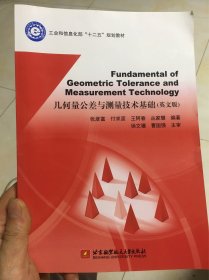
几何量公差与测量技术基础(英文版)
¥ 5 九品
仅1件
湖北十堰
认证卖家担保交易快速发货售后保障
作者张彦富、付求涯、王阿春 编
出版社北京航空航天大学出版社
出版时间2015-11
版次1
装帧平装
上书时间2024-05-21
- 在售商品 暂无
- 平均发货时间 4小时
- 好评率 暂无
- 最新上架
商品详情
- 品相描述:九品
图书标准信息
- 作者 张彦富、付求涯、王阿春 编
- 出版社 北京航空航天大学出版社
- 出版时间 2015-11
- 版次 1
- ISBN 9787512418424
- 定价 55.00元
- 装帧 平装
- 开本 16开
- 纸张 胶版纸
- 页数 235页
- 字数 397千字
- 正文语种 英语
- 丛书 工业和信息化部“十二五”规划教材
- 【内容简介】
-
《几何量公差与测量技术基础(英文版)》是为了满足“互换性与技术测量”课程的双语教学和在我国就读的留学生英文授课的需要而编写。
内容包括极限与配合、几何公差(旧标准称为形状和位置公差)、表面粗糙度等的基本术语和定义、图样标注和选用等基础内容、滚动轴承、键和花键、螺纹、圆柱齿轮等典型连结的公差与配合及其选用、尺寸链以及测量技术基础和光滑工件尺寸检验等。
《几何量公差与测量技术基础(英文版)》系统地介绍了几何量公差与测量技术的基础知识,概念阐述清楚,难点分析深入。各章均配置了适量的思考题和习题以使学生加深对所学内容的理解和应用。
《几何量公差与测量技术基础(英文版)》可作为高等学校机械和仪表类各专业双语教学或全英文授课的教材或教学参考书,也可供需要掌握几何量公差与测试技术基础知识及应用的机械设计、制造工艺、标准化和计量测试工作的工程技术人员学习参考。 - 【目录】
-
Chapter1Introduction
1.1Interchangeability
1.1.1Interchangeabilityanditsadvantages
1.2Standardization
1.2.1Standardandstandardization
1.2.2Relatedstandardsongeometricalinterchangeability
1.3SeriesofPreferredValues
1.4WhatWeCanLearnfromThisCourse
Questions
Excercise
Chapter2LimitsandFitsofPlainWorkpiece
2.1BasicTermsandDefinitions
2.1.1Termsanddefinitionsaboutgeometricalfeatures
2.1.2Shaftandhole
2.1.3Termsanddefinitionsaboutsize,deviation,tolerance
2.1.4Termsanddefinitionsaboutfits
2.2StandardsofLimitsandFits
2.2.1Fitsystem
2.2.2Symbols,designationandindicationonengineeringdrawings
2.2.3Standardtoleranceseries
2.2.4Seriesoffundamentaldeviation
2.2.5Standardizationoftoleranceclassesandfits
2.3SelectionofLimitsandFits
2.3.1Selectionofbasicsystemoffit
2.3.2Selectionofstandardtolerancegrades
2.3.3Selectionoffits
2.3.4Calculationmethod
2.4GeneralDimensionTolerance
2.4.1Generaltolerancesoflinearsizes
2.4.2Indicationofgeneraltoleranceondrawing
2.4.3Generaltolerancegradesandvalues
Questions
Exercises
Chapter3FundamentalsofGeometricalQuantityMeasurement
3.1Introduction
3.1.1Conceptofmeasurementandinspection
3.1.2Measuringprocessing
3.2MeasurementStandard~Datum~DataandDisseminationofLengthandAngle..
3.2.1Standardoflengthandangle
3.2.2Disseminationsystemoflengthandangle
3.2.3Gaugeblocksandtheirapplications
3.3MetrologicalEquipmentandMeasurementMethods
3.3.1Metrologicalequipment
3.3.2Measurementmethods
3.4MeasurementErrorandDataTreatment
3.4.1Designationofmeasurementerror
3.4.2Sourceofmeasurementerror
3.4.3Kindsandpropertiesofmeasurementerror
3.4.4Measurementaccuracy/precision
Questions
Exercises
Chapter4GeometricalTolerances
4.1General
4.1.1Causeofgeometricalerrorandeffectsonperformance
4.1.2Basictermsanddefinitions
4.1.3Symbolsandcharacteristicsofgeometricaltolerances
4.1.4Geometricaltolerancezone
4.2IndicationofGeometricalToleranceonEngineerDrawings
4.2.1Toleranceframe
4.2.2Indicationofdatumonengineeringdrawings
4.2.3Indicationoftolerancedfeatures
4.2.4Theoreticalexactdimension(TED)
4.3DefinitionofGeometricalTolerances
4.3.1Definitionandcharacteristicsofformtolerances
4.3.2Definitionandcharacteristicsoforientationtolerances
4.3.3Definitionandcharacteristicsoflocationtolerance
4.3.4Definitionandcharacteristicsofrun-outtolerance
4.4TolerancePrinciples
4.4.1Termsanddefinitionabouttoleranceprinciple
4.4.2Independencyprinciple
4.4.3Enveloperequirement(ER)
4.4.4Maximummaterialrequirement(MMR)
4.5AssessmentandMeasurementofGeometricalDeviations
4.5.1Assessmentofgeometricaldeviation
4.5.2Establishmentandembodimentofdatum
4.5.3Measuringprescriptionsofgeometricaldeviations
4.6SelectionofGeometricalTolerance
4.6.1General
4.6.2Selectionofdatum
4.6.3Selectionofgeometricalprinciple
4.6.4Selectionofgeometricaltolerancevalue
4.7GeneralGeometricalTolerances
4.7.1Generalgeometricaltolerancesgrades
4.7.2Indicationofgeneralgeometricaltolerance
Questions
Chapter5SurfaceRoughness
5.1Introduction
5.2BasicTermsandDefinitions
5.3MainEvaluationParametersofSurfaceRoughness
5.3.1Amptitudeparameters(peakandvallye)
5.3.2SpacingParameters
5.3.3Curvesandrelativeparameters
5.4PrinciplesforSelectingSurfaceRoughnessParameters
5.5GraphicalSymbolsandNotation
5.6IndicationsofSurfaceTextureRequirementsonEngineeringDrawing
5.7MeasurementTechniques
5.7.1Methodofcomparingwithstandardsample
5.7.2Lightsectionmethod
5.7.3Interferometricmethod
5.7.4Stylusinstruments
5.7.5Opticalinstruments
Exercises
Chapter6MeasurementofPlainWorkpieces
6.1BasicConcepts
6.1.IWorkpieceinspectionprinciples,safetymarginsandacceptancelimits
6.1.2Selectionofmeasurementtools
6.2PlainLimitGauges
6.2.1Functionsandkindsofplainlimitgauges
6.2.2Designprincipleofplainlimitgauges
6.2.3Toleranceoftheplainlimitgauge
6.2.4Designstepsandcalculationofthelimitssize
Questions
Exercises
Chapter7TolerancesandFitsofRollingBearing
7.1General
7.2IntroductionofRollingBearings
7.2.1Constructionandclassificationofrollingbearing
7.2.2Analysisofworkingperformanceofrollingbearings
7.2.3Internalclearanceofrollingbearings
7.2.4TolerancegradesOfrollingbearingsandapplications
7.2.5Tolerancezoneofrollingbearings
7.3SelectionofToleranceandRollingBearingsFits
7.3.1SelectionofRollingBearingFits
7.3.2Geometricaltolerancerequirementsforshaftsandholesfittedwithrollingbearings
7.3.3Surfaceroughnessrequirementsofshaftsandholesfittedwithrollingbearings
Exercises
Chapter8TolerancesandMeasurementofCylinderScrew
8.1Introduction
8.1.1Classificationandrequirementsofthread
8.1.2Basiccommonthreadtoothtypeandgeometricalparameters
8.2InfluenceofThreadGeometricalDeviationonThreadInterchangeability
8.2.1Influenceofpitchdiameterdeviation△D2a,△d2aonthreadinterchangeability
8.2.2Influenceofpitchdeviationonscrewthreadinterchangeability
8.2.3Influenceofthreadhalfangledeviation△α/2onscrewthreadinterchangeability
8.2.4Calculationofvirtualpitchdiameter
8.2.5Conditionstoguaranteethescrewthreadinterchangeability
8.3GeneralPurposeScrewThreads-toleranceZonesforScrewThread
8.3.1Tolerancegrades
8.3.2Fundamentaldeviation(tolerancepositions)
8.3.3Lengthofthreadengagement
8.3.4Threadselection,tolerancezoneandfits
8.3.5Threadmarking
8.3.6Inspectionofscrewthread
Questions
Exercises
Chapter9TolerancesandFitsofKeysandSplines
9.1TolerancesandFitsofRectangularKeysConnection
9.1.1Introductionofrectangularkeysconnectionstructure
9.1.2Toleranceandfitsoftherectangularkeyconnection
9.2TolerancesandFitsofStraight-sidedSplineConnection
9.2.1Introductionofsplineconnectionstructure
9.2.2Designation
9.2.3Tolerancesandfitsofstraight-sidedsplineconnections
Questions
Exercises
Chapter10AccuracyDesignofCylindricalInvoluteGear
10.1General
10.2EvaluationParametersofCylindricalInvoluteGear
10.2.1Definitionofevaluationparameters
10.2.3Allowablevaluesofeverydeviationofcylindricalinvolutegears
10.3AccuracyDesignofCylindricalInvoluteGears
10.3.1Selectionofaccuracygrade
10.3.2Selectionofevaluationparameters
10.3.3Deteminationofgearbacklash
10.3.4Deteminationofgearpairprecision
10.3.5Deteminationofgearblankaccuracy
Questions
Chapter11DimensionChain
11.1BasicConceptsandTermsofDimensionChain
11.1.1Basicconceptsandterms
11.1.2Formsofdimensionchain
11.1.3Establishmentofdimensionchain
11.2ToleranceCalculationsofSizeChain
11.2.1Typesofdimensionchaincalculation
11.2.2Extremevaluemethod
11.2.3Probabilitymethod
11.3MethodstoFulfillToleranceStacksofSizeChain
11.3.1Completeinterchangemethod
11.3.2Largenumberinterchangemethod
11.3.3Groupingmethod
Questions
Exercises
References
点击展开
点击收起
— 没有更多了 —

















以下为对购买帮助不大的评价